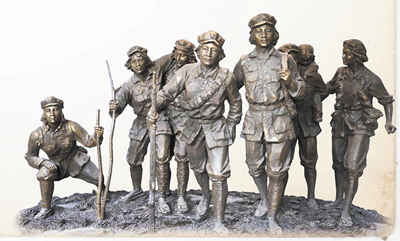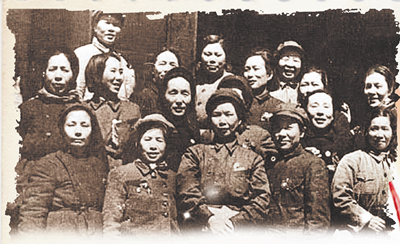 时刻新闻
时刻新闻

Female Soldiers in the Long March, a group of sculptures in the National Museum of Women and Children. [Photo/81.cn]
The Long March is known as an expedition of untold hardship and sacrifice. But female soldiers also braved its dangers.
When the 86,000-strong Central Red Army decided to make the strategic shift from Jiangxi province in 1934, only the 32 strongest women were selected to go along with the troops.
They were tasked with spreading the ideas of the Communist Party of China, taking care of the injured and raising supplies and money for the army.
Liu Ying was one of the female soldiers. She said when the troops set out, all she had was a blanket, a few clothes and food for around ten days.
She said that during the expedition, the soldiers were often exposed to the elements. On a rainy day, they were drenched, and in places where water was scarce, they were covered with dust.
At night, they slept on the wet and cold ground huddling together. Sometimes, they were so tired that they could sleep standing up.
The harsh natural conditions and scarce materials meant these young women had to shed certain feminine characteristics. They could not have long hair to avoid being identified by enemies. Hygiene was also such a big problem that some women found lice on their head. In order to avoid this, some simply shaved all their hair off.
This led to misunderstandings: when the army passed some areas, locals would ask the female soldiers to take off their clothes to identify their gender.
Moreover, the women had to overcome the pain that came during their menstrual periods. As the troops had to keep moving and battled along their way, the women had to forge ahead despite the pain.
Food was also a huge problem in the Long March. Bark, grassroots, and even leather shoes were consumed, and the female soldiers had tasted almost everything they could put into their mouth, driven by hunger.
One of the female soldiers Wang Ronghua recalled, "When the deep autumn fell, we only wore thin clothes to withstand the cold wind with our feet steeped in chilly and stinky water in the endless expanse of marsh.
"The only bag of highland barley and the salt we had were all finished. We had to eat wild herbs. When the herbs were eaten up, we found some cowhide and burnt the hair and boiled them to eat."

Some of the female soldiers that took part in the Long March pose for a photo in Beijing in 1949. [Photo/81.cn]
Despite all the sufferings, the female soldiers also experienced romance during the Long March.
Wang Quanyuan, a female solider in the convalescent troop, and Wang Shoudao, who worked in the security office, fell in love when they worked together in Zunyi, Guizhou province, in 1935.
On her wedding night, Wang received special gifts from her husband – a pistol and eight bullets. "According to the custom of my hometown, I should have made him a pair of cloth shoes, which means he could come back to me no matter where he goes. But I did not have the time and materials."
The second day after the 22-year-old bride and her husband married, their troops left Zunyi in a strategic shift.
The Red Army marched and battled through the blockade of Kuomintang troops along its way. They saw each other again almost half a year later.
But soon, the troops set out on different directions, and little did they know, they would not reunite for another half a century.
In August 1936, Wang Quanyuan was appointed as the head of a women's regiment with more than 1,300 soldiers, the first female forces in the history of the Communist Party of China.
When the troops marched in northwestern Gansu province to open up a new lifeline in the west, they were attacked by the Kuomintang forces who were supposed to be their allies in the fight against the Japanese.
The battle saw the death of more than 1,000 female soldiers, and many were taken prisoner, including Wang herself.
At the coercion of the commander of the Kuomintang force to marry him, Wang pretended to agree. That night she fled. Dressed up as a man, she made her way to the office of the Eighth Route Army in Lanzhou, the provincial capital of Gansu province.
The Red Army was then integrated into the Kuomintang forces and named Eighth Route Army when the Communist Party of China allied with the Kuomintang regime in the war against Japanese aggression (1937-1945).
When Wang finally arrived in Lanzhou after many hardships, however, she was told she could not rejoin the troop because they could not verify her identity.
In desperation, she begged her way home back to Jiangxi province.
It was not until 1995 that Wang reunited with her husband Wang Shoudao when she went to Beijing to attend a meeting of the National Women's Federation. The day she met her husband again, she bought a pair of cloth shoes for him, and they took the first and last photo together of their lives.



